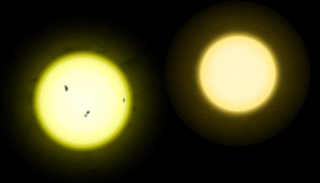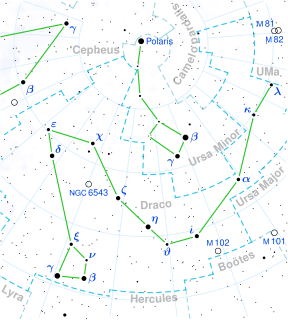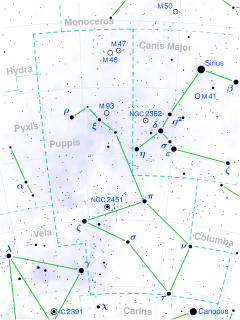Related Research Articles

Solar-type star, solar analogs, and solar twins are stars that are particularly similar to the Sun. The stellar classification is a hierarchy with solar twin being most like the Sun followed by solar analog and then solar-type. Observations of these stars are important for understanding better the properties of the Sun in relation to other stars and the habitability of planets.

HD 66141 is a single star in the equatorial constellation of Canis Minor. It has the Bayer designation G Canis Minoris, the Gould designation 50 G. Canis Minoris, and has the HR 3145 identifier from the Bright Star Catalogue. When first catalogued it was in the Puppis constellation and was designated "13 Puppis", but it subsequently migrated to Canis Minor. Bode gave it the Bayer designation of Lambda Canis Minoris.

Chi Draconis is a star system in the constellation Draco.
58 Eridani is a main-sequence star in the constellation Eridanus. It is a solar analogue, having similar physical properties to the Sun. The star has a relatively high proper motion across the sky, and it is located about 43 light years distant. It is a probable member of the IC 2391 moving group of stars that share a common motion through space.

Nu Phoenicis is a F-type main-sequence star in the southern constellation of Phoenix. It is visible to the naked eye with an apparent visual magnitude of 4.95. This is a solar analogue, meaning its observed properties appear similar to the Sun, although it is somewhat more massive. At an estimated distance of around 49.5 light years, this star is located relatively near the Sun.

Tau Puppis, Latinized from τ Puppis, is a star in the southern constellation of Puppis, near the southern constellation boundary with Carina. It is visible to the naked with an apparent visual magnitude of +2.95 and is located at a distance of about 182 light-years from Earth. The variable radial velocity of this system was detected by H. D. Curtis and H. K. Palmer in 1908, based on observations made at the D. O. Mills Observatory. It is a spectroscopic binary star system, with the presence of the secondary component being revealed by the shifts of absorption lines in the spectrum resulting from the Doppler effect. The two components orbit each other with a period of 1,066.0 days and a low eccentricity of 0.090.
HD 208177 is a double star system in the equatorial constellation of Aquarius. They are faintly visible to the naked eye with an apparent magnitude of 6.20. The pair have an angular separation of 19.113″. The primary component is an evolved subgiant star with a stellar classification of F5IV. It has an estimated 163% of the Sun's mass and is about 1.7 billion years old
HD 60532 is a white (F-type) main sequence star located approximately 84 light-years away in the constellation of Puppis, taking its primary name from its Henry Draper Catalogue designation. It is calculated to be 1.44 times more massive than the Sun. The star is only 59% as old as the Sun and has metallicity of only 38% that of the Sun. In 2008, two extrasolar planets were discovered in orbit around it.
HD 43848 is a 9th magnitude K-type subgiant star located approximately 123 light-years away in the constellation of Columba. The star is less massive than the Sun.
HD 44594 is a star in the southern constellation Puppis. It has an apparent visual magnitude of 6.64, so it can be seen with the naked eye from the southern hemisphere under good viewing conditions. Based upon parallax measurements, it is located at a distance of about 82 light-years from the Earth, giving it an absolute magnitude of 4.56.
HD 49933 is a binary star system in the equatorial constellation of Monoceros, the unicorn. The HD designation indicates the identifier of the star found in the Henry Draper catalogue. At an apparent magnitude of 5.8, this star can just be seen with the naked eye under suitably dark conditions. Based upon parallax measurements from the Hipparcos mission, the distance to HD 49933 is about 97 light-years with a 1% margin of error.

Rho Puppis, formally named Tureis, is a star in the southern constellation of Puppis. With an average apparent visual magnitude of 2.78, it is the third-brightest member of this generally faint constellation. Based upon parallax measurements made during the Hipparcos mission, Rho Puppis is located at a distance of 63.5 light-years from the Sun. It is the prototype of the ρ Puppis class of evolved Am stars.
Phi2 Ceti, Latinized from φ2 Ceti), is a star located in the equatorial constellation of Cetus. φ2 Ceti is also known as 19 Cet, and HD 4813. Based upon parallax measurements, it is located about 51 light years away. It has an apparent visual magnitude of +5.19, making it bright enough to be seen with the naked eye. The star is drifting further away with a radial velocity of +8 km/s.

HD 70555 is a class K2.5II-III star in the constellation Puppis. Its apparent magnitude is 4.83 and it is approximately 1,010 light years away based on parallax.

HD 61831 is a class B2.5V star in the constellation Puppis. Its apparent magnitude is 4.84 and it is approximately 556 light years away based on parallax.
HD 9986 is a Sun-like star in the equatorial constellation of Pisces. With an apparent visual magnitude of 6.77, it lies below the normal limit for visibility with the naked eye. The star is located at a distance of 83 light years from the Sun as determined from parallax measurements, but it is drifting closer with a radial velocity of −21 km/s.
HD 150248 is a Sun-like star 87 light-years from the Sun. HD 150248 is a G-type star and a near solar twin. HD 150248's photometric color is also very close to that of the Sun; however, it has a lower abundance of metals, and has an apparent visual magnitude of 7.02. At 6.2 billion years old, this star is 1.6 billion years older than the Sun and has passed the stable burning stage. HD 150248 is found on the border between the constellations Scorpius and Ara.
HD 117939 is a Sun-like star in the southern constellation of Centaurus. With an apparent visual magnitude of 7.29 it is too faint to be viewed with the naked eye, but is within the range of binoculars or a small telescope. It is located at a distance of 98.5 light years from the Sun based on parallax measurements, and is drifting further away with a radial velocity of +82 km/s. This is an intermediate disk star with a high proper motion, traversing the celestial sphere at an angular rate of 0.68 arcsec yr−1.

Iota Crateris (ι Crateris) is the Bayer designation for a binary star system in the southern constellation of Crater. It is faintly visible to the naked eye with an apparent visual magnitude of 5.48. According to the Bortle scale, this means it can be viewed from suburban skies at night. Based upon an annual parallax shift of 37.41 mas, Iota Crateris is located 87 light years from the Sun.
9 Puppis is a binary star system in the southern constellation of Puppis. It was originally designated 9 Argus, being part of the now defunct Argo Navis constellation. The system is faintly visible to the naked eye as a point of light with a combined apparent visual magnitude of 5.16. The magnitude difference between the two stars is 0.65. Parallax measurements yield a distance estimate to 9 Puppis of approximately 54 light years from the Sun, with the dynamic and trigonometric parallaxes for the system being in close agreement. It is drifting closer with a systemic radial velocity of –21 km/s. The motion of the system through space is predicted to bring it as close as 42.2 light-years in about 292,000 years.
References
- ↑ "HD 71334". Sky Map. 2009. Retrieved 2016-09-26.
- 1 2 3 Van Leeuwen, F. (2007). "Validation of the new Hipparcos reduction". Astronomy and Astrophysics. 474 (2): 653–664. arXiv: 0708.1752 . Bibcode:2007A&A...474..653V. doi:10.1051/0004-6361:20078357. S2CID 18759600.
- 1 2 3 4 5 6 Carlos, Marília; Nissen, Poul E.; Meléndez, Jorge (2016). "Correlation between lithium abundances and ages of solar twin stars". Astronomy & Astrophysics. 587: A100. arXiv: 1601.05054 . Bibcode:2016A&A...587A.100C. doi:10.1051/0004-6361/201527478. S2CID 119268561.
- ↑ Gray, R. O.; Corbally, C. J.; Garrison, R. F.; McFadden, M. T.; Bubar, E. J.; McGahee, C. E.; O'Donoghue, A. A.; Knox, E. R. (2006). "Contributions to the Nearby Stars (NStars) Project: Spectroscopy of Stars Earlier than M0 within 40 pc-The Southern Sample". The Astronomical Journal. 132 (1): 161–170. arXiv: astro-ph/0603770 . Bibcode:2006AJ....132..161G. doi:10.1086/504637. S2CID 119476992.
- ↑ dos Santos, Leonardo A.; et al. (August 2016), "The Solar Twin Planet Search. IV. The Sun as a typical rotator and evidence for a new rotational braking law for Sun-like stars", Astronomy & Astrophysics, 592: 8, arXiv: 1606.06214 , Bibcode:2016A&A...592A.156D, doi:10.1051/0004-6361/201628558, S2CID 53533614, A156.
- ↑ Williams, D.R. (2004). "Sun Fact Sheet". NASA . Retrieved 2009-06-23.
- ↑ HD 71334 at SIMBAD - Ids - Bibliography - Image.